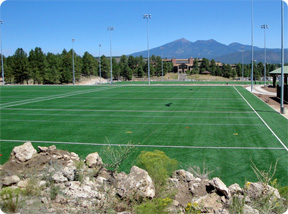
At Northern Arizona University, going green starts from the ground up. A brand-new recreational complex, built with student fees to meet the student body’s request for more recreational space, is a lesson in sustainability.
Nestled in a park-like setting are two huge fields, two sand volleyball courts and a throwing area for discus, shot and hammer. An 18-hole disc golf course wraps its way around the perimeter of the fields through the ponderosa pines. Two round buildings, which house equipment storage in one and restrooms with lockers in the other, are joined overhead by a shade ramada.
The complex features synthetic grass, Dark Skies-compliant lighting, recycled blue-jean insulation, reclaimed water and recycling of natural resources disrupted by construction.
“In this particular project, any stone or soil that we took out of the ground was re-used in our sub-structure. The trees that had to be removed were stripped of their limbs and used in the ground covering of the throwing area,“ said Rich Chapman, a senior project manager at Capital Assets. “The larger logs were donated to the ceramics department to fire the kilns.”
The synthetic grass—Stadia Grass 45—has a life expectancy of 10-15 years, is not affected by the weather, does not require water and has the look and feel of natural grass.
“The new fields greatly expand our ability to run programs without wear and tear on the fields. We now have a smooth, safe playing surface all year,” observed Scott Cassells, director of Campus Recreation Services.
An added bonus is a warm place to sit when the weather turns cooler. The infill of the grass contains sand and ground-up tire pellets which absorb heat throughout the day. This creates a radiating heat effect which helps snow to melt more quickly in the winter.
“In addition, the two main fields can be divided into six fields. A concert can be held there. The fields are designed to handle a number of events,” Chapman added.
Another key element of this project is the lighting. Eight pole-mounted lights per field direct the light toward the ground, not the sky. The lights are turned on for events but students can access the lights at half-power for a pick-up game by swiping their NAU ID cards on card readers located on the poles near the restrooms.
The lights automatically shut off at 11 p.m. whether there is an event or if they are being used at half-power. The restrooms also can be accessed at any time with an NAU ID card.
The complex is the first phase of a larger project to upgrade student facilities. A new health and learning center, also funded primarily by student fees, should break ground in September and will offer upgraded recreation facilities, a health center, classrooms and athletics locker rooms.
The field project was originally estimated at $8.3 million, but the completed project cost less at $7.8 million. The savings allowed for the two sand volleyball courts to be built, a renovation of the disc-golf course and a walking path around the area.
“The contractor (Valley Rain Construction) was great at keeping costs down and recycling materials on site for use in the project,” Cassells said. “We were able to turn this into a recreational complex from just the field project.”



